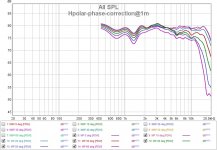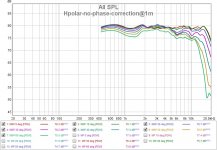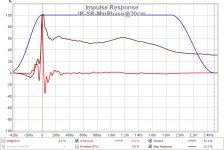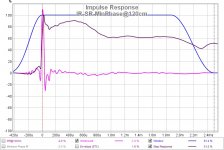If there is audible difference with and without phase linearization of any system in any environment shouldn't it be audible if recorded with a mic as well? Could be interesting to hear such recording, if someone had capability and time to make such recording available! 🙂
Everything is recorded with a microphone, except occasional electric bass into a DI box. Even then, there's often a microphone around.
Microphones are inherently minimum-phase. ie, if the frequency response is flat, so is the phase response.
Chris
Last edited:
This is a good idea. But please use group delay patterns which are typical for analog crossovers and not like Blauert and Laws who used used a group delay that was of the peaking narrow band type.
Regards
Charles
Sure, easy enough to do.
I was thinking of just copying the phase shift of an LR4 crossover at 2kHz.
Then, we could do a 3-way version of LR4 at 300Hz and 3kHz.
Three options (linear, 2-way, 3-way) to choose from. If a statistically significant number of people can reliably identify which is which, then we're on to something.
Chris
Chris, yeah sorry i wasn't writing carefully. I ment if someone has a playback system with capability to switch linear phase on easily and hears a difference by doing so the difference should come through to all of us if the person would record it and post an audio file here. It would not be very scientific but at least it would be a cool thing to check out, at least for me 🙂
I see your point, but with the push of a button we can make our own systems have arbitrary phase shifts.
All that's needed is a PC source.
That said, I've got some decent microphones here, and could record my system having the FIR processing being switched on/off. I just don't know how useful that would be.
Chris
All that's needed is a PC source.
That said, I've got some decent microphones here, and could record my system having the FIR processing being switched on/off. I just don't know how useful that would be.
Chris
Hi tmuikki, you bring up an interesting point...one i've wondered about for a while when making linear phase audibility tests.....
Point being, if we have a perfectly linear speaker output (mag and phase), does it eliminate any group delay that is inherent in the recording?
It can't, it seems.
It should only reproduce the recording exactly as it was made.
So for those of us who prefer amplified music, we get whatever group delay was in the recording system.
Even when we achieve flat phase with our speakers, we are still somewhat at the mercy of the recording.
And our speaker's group delay simply becomes additive to any inherent group delay.
If i make two recordings of my speakers, one that is linear phase and one that uses traditional xovers, here is what i think happens....
The linear phase recording should hopefully exactly match the recording, both mag and phase / group delay)
The traditional xovers should match the recording in magnitude, but not in phase / group delay.
(Both cases totally depending on how well speaker was actually tuned.)
So if i posted these two speaker recordings along with the original tack used, here's what I think folks would hear on their speakers.
The linear phase recording should sound the same as the original track, and both will be heard under the amount of group delay in the listener's system.
The traditional xover recording should add its group delay to the listener's system group delay, and perhaps be audibly different.
But, if there is any audible difference, it is that of more group delay vs less.....iow, more-crooked on top of crooked-to-begin with.
It's a test of how much increased group delay becomes noticeable when group delay is already present.
We could keep raising the order of the traditional xovers until everyone says the sound sucks i think, to find a threshold of audibility on whatever speaker and tuning they are using.
But that probably decays more into a test about folks speaker tuning abilities and listening environments that anything else, i guess.
The only valid test in my mind, is to tune a speaker to flat mag and phase via linear phase xovers , and then substitute the linear phase xovers with traditional xovers, leaving all else the same. A/B those two cases.
(Some folks will say you can apply phase correction to the entire speaker with the traditional xovers in place, to make this A/B comparison. My experience is this does not work as well as direct xover substitutions, because it is too "spot tuned" specific...fwiw.)
The very best way to A/B i've found (or test speakers in general),
is Tom Danley's recommendation of using generation loss recordings.
Record your speaker playing a track. Use the recording for playback and record again. Use that and record again. Repeat process and see how many recording cycles your speaker survives. It takes a really good speaker to keep from getting ugly very early!
Point being, if we have a perfectly linear speaker output (mag and phase), does it eliminate any group delay that is inherent in the recording?
It can't, it seems.
It should only reproduce the recording exactly as it was made.
So for those of us who prefer amplified music, we get whatever group delay was in the recording system.
Even when we achieve flat phase with our speakers, we are still somewhat at the mercy of the recording.
And our speaker's group delay simply becomes additive to any inherent group delay.
If i make two recordings of my speakers, one that is linear phase and one that uses traditional xovers, here is what i think happens....
The linear phase recording should hopefully exactly match the recording, both mag and phase / group delay)
The traditional xovers should match the recording in magnitude, but not in phase / group delay.
(Both cases totally depending on how well speaker was actually tuned.)
So if i posted these two speaker recordings along with the original tack used, here's what I think folks would hear on their speakers.
The linear phase recording should sound the same as the original track, and both will be heard under the amount of group delay in the listener's system.
The traditional xover recording should add its group delay to the listener's system group delay, and perhaps be audibly different.
But, if there is any audible difference, it is that of more group delay vs less.....iow, more-crooked on top of crooked-to-begin with.
It's a test of how much increased group delay becomes noticeable when group delay is already present.
We could keep raising the order of the traditional xovers until everyone says the sound sucks i think, to find a threshold of audibility on whatever speaker and tuning they are using.
But that probably decays more into a test about folks speaker tuning abilities and listening environments that anything else, i guess.
The only valid test in my mind, is to tune a speaker to flat mag and phase via linear phase xovers , and then substitute the linear phase xovers with traditional xovers, leaving all else the same. A/B those two cases.
(Some folks will say you can apply phase correction to the entire speaker with the traditional xovers in place, to make this A/B comparison. My experience is this does not work as well as direct xover substitutions, because it is too "spot tuned" specific...fwiw.)
The very best way to A/B i've found (or test speakers in general),
is Tom Danley's recommendation of using generation loss recordings.
Record your speaker playing a track. Use the recording for playback and record again. Use that and record again. Repeat process and see how many recording cycles your speaker survives. It takes a really good speaker to keep from getting ugly very early!
I'm scared to do it even once.The very best way to A/B i've found (or test speakers in general),
is Tom Danley's recommendation of using generation loss recordings.
Record your speaker playing a track. Use the recording for playback and record again. Use that and record again. Repeat process and see how many recording cycles your speaker survives. It takes a really good speaker to keep from getting ugly very early!
But what would it prove anyway? You introduce a number of factors, including the listening (now recording) environment, mic setup, quality of recording equipment and ADC stream, etc.
Very interesting mark, I never thought in that perspective, thanks! Scientific tests and study is needed to determine if inter-driver phase is audible to ear. Comparing two systems or same system with two settings only reveals the ability to tune the said system, and not much about if phase is audible or not. Cool 🙂
Just a thought: If the person in control is experienced and honest and says that this phase changing preset button I've setup here will make the sound better and then demonstrates it, I would be very interested about whats going on and surely believe the phase matters. But in the end I might not mind if it was the change in phase or something completely different that made the system sound better, I' d still use the better sounding setting/system until even better sounding system comes across 🙂 just rambling, I've never had linear phase system so I'm just curious, and saving up to buy one someday. Jolly weekend everyone, going to buy me some beer and listen some music 😀
Just a thought: If the person in control is experienced and honest and says that this phase changing preset button I've setup here will make the sound better and then demonstrates it, I would be very interested about whats going on and surely believe the phase matters. But in the end I might not mind if it was the change in phase or something completely different that made the system sound better, I' d still use the better sounding setting/system until even better sounding system comes across 🙂 just rambling, I've never had linear phase system so I'm just curious, and saving up to buy one someday. Jolly weekend everyone, going to buy me some beer and listen some music 😀
But what would it prove anyway? You introduce a number of factors, including the listening (now recording) environment, mic setup, quality of recording equipment and ADC stream, etc.
It's a way to quickly find or prove where a speaker's major shortcoming are, ime.
Because the iterations amplify what deviates from faithful reproduction, while keeping what's faithful unchanged.
You are so correct about the listening environment factor. Reflections/reverb quickly destroy the test.
It's not even worth doing unless done outside, and then the farther away from any reflective boundaries the better. (or use a test track without deep bass)
My experience with the other factors,.. mic setup, quality of recording equip, ADC etc, is that as long as a certain minimum level of quality is kept, they contribute maybe nothing in comparison to how quickly the speaker melts by itself.
I've used the Zoom H5 with its own mic capsule and with an external measurement mics of different quaity, and also the USB recording capacity of an X-32 mixer which is only 16 bit.
None of that seemed to matter, the speaker and it's tuning dominated big time. (and again, keeping reflections out)
If i were trying to see how far i could make it, like out to 4 or more decent generations, i guess maybe then the quality of mic and recorder could come into play....would be a nice problem to have 🙂
My bet is a big majority of speakers would probably not survive two rounds, and many won't get past the first. It really does make it obvious where the shortcomings are. Not for the faint of heart !
Just to put a few pictures to the words. This is an active 3 way using LR4 XO that I'm currently playing with. The phase correction overlay can be switched on/off with minimal effect (1.5dB) on the FR magnitude. The measurements are at 1m out and midrange height with gating and FDW. It is hard (for me, YMMV) to tell the sound difference between the two.
Pic#2 - compare FR magnitude differences for on/off phase correction
Pic#3,4 - amount of excess phase to correct and IR + SR responses
Pic#5,6 - phase corrected back to "min phase" with IR + SR responses
.
Pic#2 - compare FR magnitude differences for on/off phase correction
Pic#3,4 - amount of excess phase to correct and IR + SR responses
Pic#5,6 - phase corrected back to "min phase" with IR + SR responses
.
Attachments
-
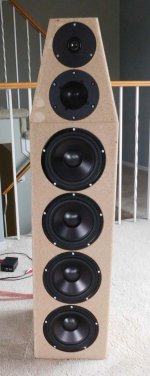 DSCN8112r.jpg83.6 KB · Views: 102
DSCN8112r.jpg83.6 KB · Views: 102 -
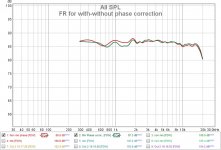 FR for with-without phase correction.jpg98.4 KB · Views: 103
FR for with-without phase correction.jpg98.4 KB · Views: 103 -
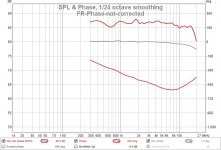 FR-Phase-not-corrected.jpg99.8 KB · Views: 102
FR-Phase-not-corrected.jpg99.8 KB · Views: 102 -
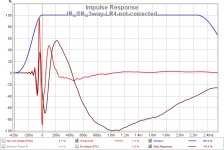 IR_SR_3way-LR4-not-corrected.jpg100.7 KB · Views: 105
IR_SR_3way-LR4-not-corrected.jpg100.7 KB · Views: 105 -
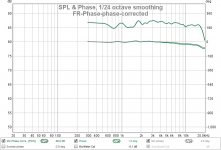 FR-Phase-phase-corrected.jpg93.5 KB · Views: 105
FR-Phase-phase-corrected.jpg93.5 KB · Views: 105 -
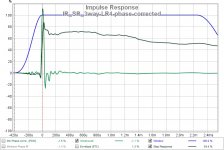 IR_SR_3way-LR4-phase-corrected.jpg91.5 KB · Views: 58
IR_SR_3way-LR4-phase-corrected.jpg91.5 KB · Views: 58
...
The very best way to A/B i've found (or test speakers in general),
is Tom Danley's recommendation of using generation loss recordings.
Record your speaker playing a track. Use the recording for playback and record again. Use that and record again. Repeat process and see how many recording cycles your speaker survives. It takes a really good speaker to keep from getting ugly very early!
Tried this last night while drinkin beer and noodling around with a mic. First generation already sounded like poo 😀 this was in livingoom with measurement mic. Reflections and room modes seemed to have larger effect in the recording than live listening so measuring outside would be mandatory with phase audibility tests 😀 Anyway, I feel I spotted some problems and tuned the IIR eq I have and managed to get the system sound a bit better so this was a useful method. I've got no idea what the phase is and I believe I still have more meaningfull variables to tweak before trying out linear phase.
Yep, first generation indoors = no good already.
For indoors, a related, interesting, and easy to do experiment, is to put headphones on and listen to the output of a measurement mic while playing a track .
It supposedly takes much the brain's processing of direct and reflected sound out of the picture. Came also from TomD..
Pls don't think i'm touting linear phase as something that automatically makes for better sound. After frequency response, i think room acoustics matter waay more when indoors. And pattern control too. And C-to-C spacing in the design from the gitgo, etc.
Ime/imo, linear phase is the icing on the cake. Much easier to taste outdoors with high dynamics, but when everything is right it can come alive indoors too.
At any rate, i certainly don't recommend someone get in a hurry to acquire lin phase 🙂
For indoors, a related, interesting, and easy to do experiment, is to put headphones on and listen to the output of a measurement mic while playing a track .
It supposedly takes much the brain's processing of direct and reflected sound out of the picture. Came also from TomD..
Pls don't think i'm touting linear phase as something that automatically makes for better sound. After frequency response, i think room acoustics matter waay more when indoors. And pattern control too. And C-to-C spacing in the design from the gitgo, etc.
Ime/imo, linear phase is the icing on the cake. Much easier to taste outdoors with high dynamics, but when everything is right it can come alive indoors too.
At any rate, i certainly don't recommend someone get in a hurry to acquire lin phase 🙂
mark, jeah sorry if my output makes you feel like that it wasn't my purpose. I know your stance on the subject pretty well, reading the forums too much 🙂 I need processor and amps to get speaker prototyping to stereo era, I've been doing mono for almost two years 😀 might as well save up a little and buy FIR capable processor at once, thats my status. Meanwhile I'm chatting too much on the forums since no chance to rip plywood either at the moment. Jolly weekend!
Just to put a few pictures to the words. This is an active 3 way using LR4 XO that I'm currently playing with. The phase correction overlay can be switched on/off with minimal effect (1.5dB) on the FR magnitude. The measurements are at 1m out and midrange height with gating and FDW. It is hard (for me, YMMV) to tell the sound difference between the two.
Pic#2 - compare FR magnitude differences for on/off phase correction
Pic#3,4 - amount of excess phase to correct and IR + SR responses
Pic#5,6 - phase corrected back to "min phase" with IR + SR responses
.
nice. can you do 0-90deg measurements with and without phase processing
Just to put a few pictures to the words. This is an active 3 way using LR4 XO that I'm currently playing with. The phase correction overlay can be switched on/off with minimal effect (1.5dB) on the FR magnitude. The measurements are at 1m out and midrange height with gating and FDW. It is hard (for me, YMMV) to tell the sound difference between the two.
Nice work 🙂
I share your experience of not hearing much/ if any difference in a phase correction overlay.
(I've used the term 'global FIR correction' in a number of past posts, to describe a phase correction overlay)
Was your overlay created using measurements at 1m?
Was it phase corrected only, or mag and phase?
I ask because i think the reason overlays breakdown is that they tune too specifically to one spot.
It becomes a case of over tuning i think.
Pretty easy to identify over tuning, just move the measurement mic a bit and see how much the near perfect impulse from the correction spot falls apart. (almost always falls apart too much with overlays ime)
I've found alternatively when linear phase xovers are used, impulse variance from different mic locations goes down substantially, vs the tuning spot.
Finding a good tuning spot via outdoor polars, or using an average of spots also helps minimize variance.
However, it seldom gives a near perfect impulse at any one spot.
In fairness to the overlay method, i guess the same polar best spot determination or using a measurement average, might be used to create the overlay and reduce impulse variance. Needs investigation i think.
I just don't see the point though, because once two drivers sum together, they are no longer minimum phase, and any correction to their summed region seems it can only be to a spot.
Anyway, the only other thing i might add is a growing wariness of using gating or nearfield measurements. Could go into why, but no doubt i've already said enough 😱
It's a PIA, but outdoor ground plane measurements are about all i trust anymore.
You bet tmuikki 🙂
Me too, too much time on forums lol
Enjoy your weekend !
tmulkku would have been more hilarious typo. 😀
all you guys have a nice weekend
^Hah, wouldn't be the first time 😀 in forum context that woud translate to an ******* 😀
Last edited:
thx manninen,
fixed the typo...
but no clue re tmulkku means ?
You too, and everyone, great weekend !
fixed the typo...
but no clue re tmulkku means ?
You too, and everyone, great weekend !
nice. can you do 0-90deg measurements with and without phase processing
The polars (relative to axial) look about the same. The dip (1-2K) with phase correction could also be fine tuned but I wanted the exact same mag corrections for both.
Attachments
Last edited:
Nice work 🙂
Was your overlay created using measurements at 1m?
Was it phase corrected only, or mag and phase?
Yes, measurement at 1m and phase correction based that measurement. I have separate mag and phase corrections for this experiment. I keep the same mag correction and turn phase correction on/off.
I ask because i think the reason overlays breakdown is that they tune too specifically to one spot.
It becomes a case of over tuning i think.
Pretty easy to identify over tuning, just move the measurement mic a bit and see how much the near perfect impulse from the correction spot falls apart. (almost always falls apart too much with overlays ime)
I've found alternatively when linear phase xovers are used, impulse variance from different mic locations goes down substantially, vs the tuning spot.
This is a very good point and one I question all time. It's a 3D sound field and we can only measure a "point" with a mic. So, have we optimized a point at the expense of the field? A few graphs below show how well the phase correction holds over distance. It was interesting to see. It's a mute point for me as I can't hear the difference, so its rarely used 🙂
Anyway, the only other thing i might add is a growing wariness of using gating or nearfield measurements. Could go into why, but no doubt i've already said enough 😱
It's a PIA, but outdoor ground plane measurements are about all i trust anymore.
Also a good point. However, gating is really the only option if you're measuring indoors. As long as you're far enough away to include the baffle effects and driver blending its still valid IMO. Averaging over several listening area spots is also preferred.
Attachments
- Home
- Loudspeakers
- Multi-Way
- Inter-Driver Phase Audibility
